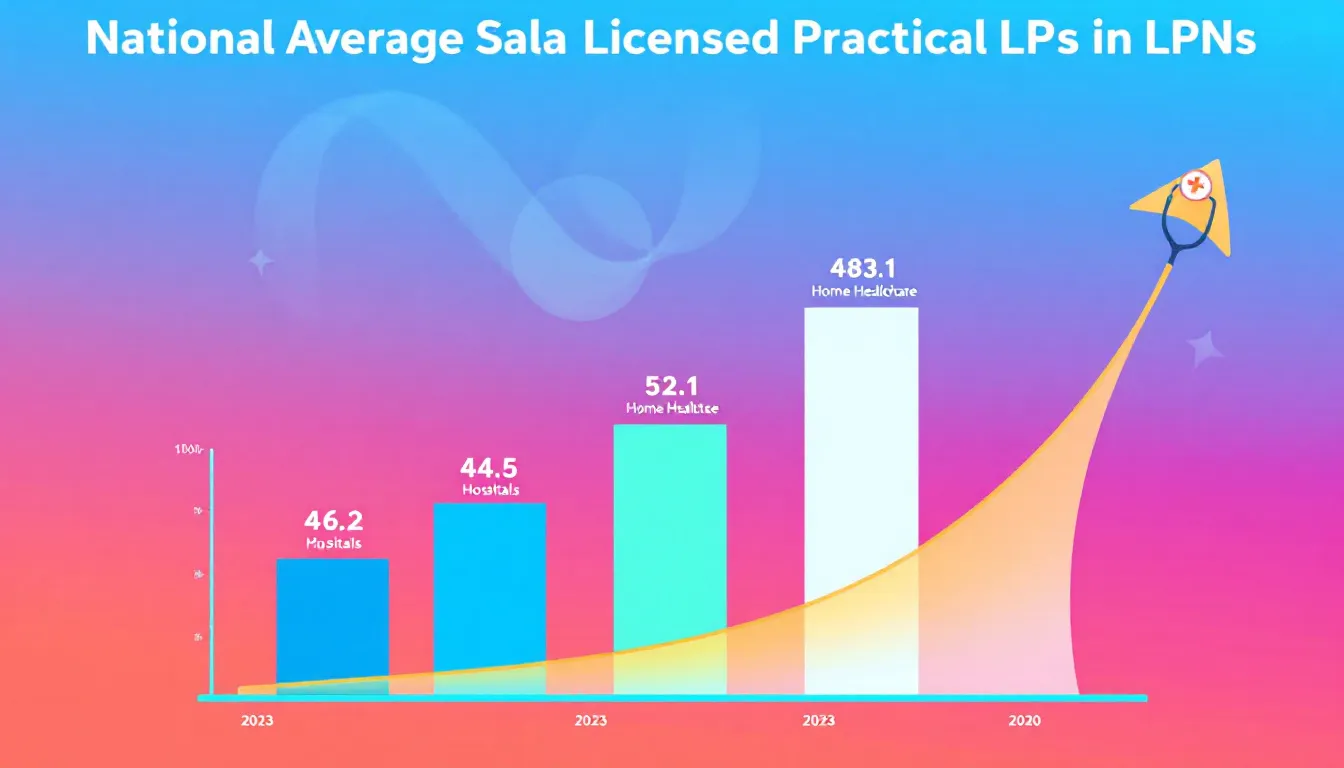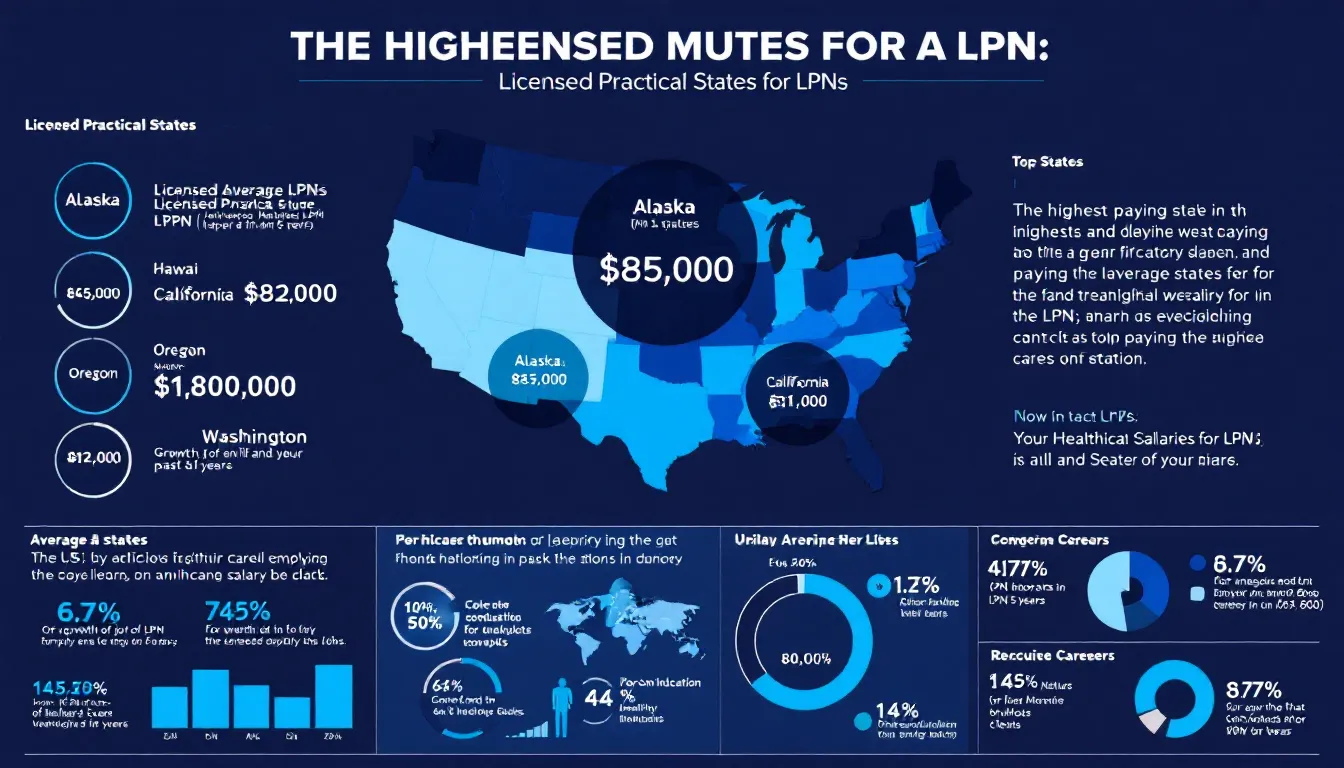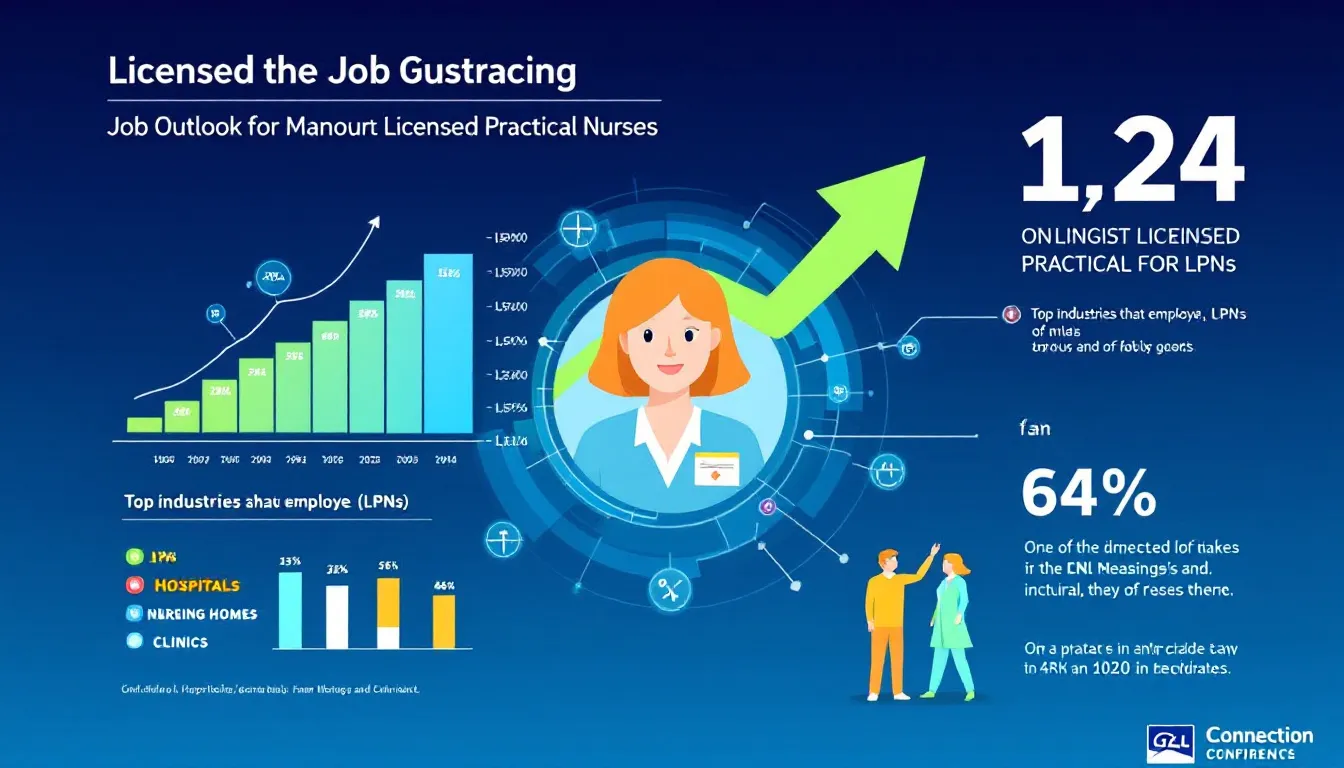Top Insights on the Salary of an LPN for 2024
If you’re considering a career as a Licensed Practical Nurse (LPN) or are already working as one, knowing the salary outlook for 2024 is crucial. The salary of an LPN can vary widely based on factors like location, experience, and place of employment. In this article, we’ll break down the national average salary, highlight the highest and lowest-paying states, and explore how different settings can impact your earnings.
Key Takeaways
- The national average salary for LPNs in 2024 is approximately $60,790 annually, with significant variations based on location, experience, and employment settings.
- California offers the highest average salary for LPNs at $76,580, while Mississippi has the lowest at around $49,050, highlighting stark regional disparities.
- Career advancement opportunities, such as obtaining an ADN or BSN, can significantly increase earning potential and job satisfaction for LPNs.
Understanding the Role of a Licensed Practical Nurse (LPN)

Licensed Practical Nurses (LPNs), also known as Licensed Vocational Nurses (LVNs) in states such as California and Texas, are pivotal in patient care. They perform a variety of essential tasks, including:
- Monitoring patient health
- Performing basic care tasks
- Taking vital signs
- Administering medications
These responsibilities ensure patient safety and comfort, and LPNs often become the friendly face patients see regularly.
LPNs usually work under the supervision of Registered Nurses (RNs) and physicians, assisting with daily patient care. This collaboration allows LPNs to manage routine aspects of nursing, freeing RNs to handle more complex medical tasks.
To become an LPN, one must complete a vocational training program, typically lasting around twelve months, and pass the NCLEX-PN exam. This shorter training period enables quicker entry into the nursing field compared to other nursing paths.
LPNs or LVNs are integral to the healthcare system. While their roles may vary slightly by state, their dedication to patient care remains consistent. Knowing the responsibilities and training required for LPNs helps appreciate their contributions to healthcare and understand the factors influencing their salaries.
LPN vs. LVN: What’s the Difference?
Licensed Practical Nurses (LPNs) and Licensed Vocational Nurses (LVNs) are essentially the same roles with different titles depending on the state. In Texas and California, these healthcare professionals are known as LVNs, while in the rest of the United States, they are referred to as LPNs. Despite the difference in name, both LPNs and LVNs perform similar duties, providing essential nursing care under the supervision of registered nurses and physicians.
LPNs and LVNs work in a variety of healthcare settings, including hospitals, nursing homes, clinics, and private homes. Their responsibilities include monitoring patient health, administering medications, and assisting with daily living activities. This role is crucial in ensuring patient comfort and safety, making LPNs and LVNs indispensable members of the healthcare team.
National Average Salary for LPNs in 2024

The national average lpn salary for LPNs in 2024 is approximately $60,790 annually or $29.23 per hour. The median annual salary is slightly lower at $54,620, with a median hourly wage of $26.26. These figures can vary significantly based on factors such as state of employment, type of healthcare facility, licensed practical nurse salary, average lpn pay, average lpn salary, and level of experience.
Data from the Bureau of Labor Statistics shows that LPNs in government jobs tend to earn higher salaries, averaging $57,200 per year, while those in physicians’ offices average $48,300 annually. These differences highlight the importance of considering employment settings and geographic location when evaluating potential earnings.
Highest-Paying States for LPNs

Location significantly impacts LPN salaries. California offers the highest lpn average salary at $76,580 annually, reflecting its cost of living and demand for healthcare professionals. Rhode Island and Washington also rank high, with average salaries of $75,470 and $75,410, respectively. The lpn salary in these states highlights the regional differences in compensation for licensed practical nurses.
Alaska and Massachusetts follow closely with average annual salaries of $74,260 and $73,400, respectively. These figures highlight significant regional disparities in LPN earnings, influenced by salary by state, state population, demand for healthcare services, and cost of living.
LPNs seeking the best financial prospects might consider employment in these high-paying states. However, weighing potential salary against the cost of living and other personal factors is important when making such a move.
Lowest-Paying States for LPNs
Mississippi ranks as the state with the lowest average salary for LPNs at around $49,050 annually. Alabama follows closely with approximately $48,320. South Dakota and West Virginia also have lower average salaries at $49,580 and $50,090, respectively.
In Puerto Rico, LPNs earn significantly less, averaging just $27,430 annually. These figures are well below the national average, indicating potential financial challenges for LPNs in these regions compared to higher-paying areas.
Top Cities for LPN Salaries

Cities can significantly impact LPN salaries. Soledad, California, stands out with the highest hourly wage at $43.94. In the San Jose-Sunnyvale-Santa Clara area, LPNs earn an impressive $80,590 annually, making it a top city for LPN earnings.
San Francisco-Oakland-Hayward, California, also offers competitive salaries at $80,470 annually for LPNs. These cities highlight the potential for higher earnings in specific metropolitan areas, influenced by local demand for healthcare services, cost of living, and availability of specialized medical facilities.
Employment Settings and Their Impact on LPN Salaries
LPNs work in various settings, each impacting salary potential. Hospitals typically offer higher salaries compared to long-term care facilities due to the higher demand for skilled nursing facilities and the complexity of tasks in hospital settings.
LPNs in outpatient centers often earn more than those in general hospitals, reflecting the specialized skills required. Travel LPNs, who work short-term assignments in different facilities, often command higher wages due to the flexibility and additional skills required.
Overall, the type of healthcare facility significantly influences LPN salaries, with hospitals, outpatient centers, and travel nursing positions offering the highest pay.
Highest-Paying Industries for LPNs
According to the Bureau of Labor Statistics (BLS), certain industries offer higher salaries for LPNs due to the specialized nature of the work and the level of expertise required. Here are the top-paying industries for LPNs:
- Government Agencies: LPNs working in government agencies earn an average of $63,490 per year. These positions often come with additional benefits and job security.
- Insurance Carriers: LPNs employed by insurance carriers make around $62,490 annually. This industry values the medical expertise LPNs bring to assessing claims and managing patient care plans.
- Pharmaceutical and Medicine Manufacturing: With an average salary of $61,490 per year, LPNs in this industry are involved in clinical trials and patient education about medications.
- Medical and Diagnostic Laboratories: LPNs in medical and diagnostic labs earn about $60,490 annually, reflecting the specialized skills required for lab work and patient testing.
- Scientific Research and Development Services: This industry offers an average salary of $59,490 per year for LPNs, who contribute to research projects and clinical studies.
These industries provide lucrative opportunities for LPNs looking to maximize their earning potential.
Career Advancement Opportunities for LPNs
Career advancement is vital for LPNs seeking to increase earning potential and job satisfaction. Pursuing further education and specialized certifications can enhance skills and open doors to more advanced, higher-paying roles.
Two common paths for career advancement are earning an Associate Degree in Nursing (ADN) and pursuing a Bachelor of Science in Nursing (BSN).
Benefits of Earning an Associate Degree in Nursing (ADN)
Earning an ADN is a significant step for LPNs aiming to transition into more advanced roles, such as becoming a Registered Nurse (RN). This degree offers greater responsibilities, job satisfaction, and access to specialized nursing fields, enhancing professional reputation and skills.
The financial benefits are substantial, as RNs with an ADN typically earn higher salaries than LPNs. This increased earning potential makes pursuing an ADN an attractive option for career advancement.
Advantages of Pursuing a Bachelor of Science in Nursing (BSN)
A Bachelor of Science in Nursing (BSN) enhances job opportunities within healthcare, providing greater flexibility and educational paths for career advancement. Holding a BSN is associated with higher salary prospects compared to roles without this degree, boosting financial and professional standing.
Pursuing a BSN opens doors to advanced nursing positions and provides a foundation for leadership roles and specialized fields within nursing. This degree offers comprehensive education, preparing nurses for various career options.
Comparing LPN Salaries to Other Nursing Roles
Comparing LPN salaries to other nursing roles reveals significant differences. LPNs earn considerably more than Certified Nursing Assistants (CNAs), with an average annual salary difference of approximately $18,880. The median salary for LPNs is about $54,620, while CNAs earn around $35,760 annually, highlighting the financial benefits of pursuing an LPN career over a CNA role.
Registered Nurses (RNs) enjoy higher salaries, with a median of $81,220. This substantial difference underscores the financial rewards of advancing from LPN to RN. In settings like hospitals, LPNs tend to earn more than CNAs, with discrepancies up to $22,800, highlighting the practical nurse salary potential.
Job Outlook for LPNs

The job outlook for LPNs is promising, with positions projected to grow at a rate of 5% over the next decade. This steady demand is driven by the ongoing need for basic medical care. The Bureau of Labor Statistics estimates approximately 54,400 job openings for LPNs annually, providing substantial opportunities for newcomers.
This positive job outlook reflects the crucial role LPNs play in healthcare and the increasing demand for services. For those considering a career as an LPN, employment prospects are bright and promising.
States with the Highest Demand for LPNs
Certain states have a higher demand for LPNs due to their large populations and aging demographics. Here are the states with the highest demand for LPNs:
- California: With an estimated 73,000 LPN jobs available, California leads the nation in demand for LPNs. The state’s large population and extensive healthcare system drive this need.
- Texas: Texas has around 54,000 LPN jobs available, making it the second-highest state in demand. The growing population and numerous healthcare facilities contribute to this high demand.
- Florida: Florida offers approximately 44,000 LPN jobs, driven by its large retiree population and numerous long-term care facilities.
- New York: With an estimated 42,000 LPN jobs, New York has a significant demand for LPNs, particularly in urban areas with large healthcare networks.
- Pennsylvania: Pennsylvania has about 39,000 LPN jobs available, reflecting the state’s need for healthcare professionals in both urban and rural areas.
These states present excellent opportunities for LPNs seeking employment in high-demand regions.
Factors Influencing LPN Salaries
Several factors influence LPN salaries, including geographic location, industry type, and years of experience. Geographic location significantly affects salaries, with some states and cities offering higher pay. Industry type also plays a role, with LPNs in hospitals and outpatient centers typically earning more than those in long-term care facilities or clinics.
Experience and education are also critical factors. LPNs with more experience generally see increased pay, and those with additional certifications or advanced degrees tend to earn higher salaries. Understanding these factors helps LPNs make informed decisions about their career paths and potential earnings.
Trends in LPN Salary Growth
The Bureau of Labor Statistics (BLS) projects that the median annual salary for LPNs will grow by 5% from 2022 to 2032, outpacing the average growth rate for all occupations. This increase is driven by the rising demand for healthcare services, particularly in long-term care facilities and home healthcare settings.
The BLS also reports that the top 10% of LPNs earn more than $80,000 per year, while the bottom 10% earn less than $40,000 per year. This wide salary range highlights the impact of factors such as experience, location, and industry on LPN earnings.
States like Alaska, California, and Hawaii are among the highest-paying for LPNs, offering substantial financial incentives for those willing to relocate. Overall, the job outlook for LPNs is positive, with growing demand and increasing salaries providing a stable and rewarding career path.
By understanding these trends, LPNs can better navigate their career paths and make informed decisions to enhance their financial stability and job satisfaction.
Summary
In summary, the salary landscape for LPNs in 2024 is influenced by various factors, including geographic location, employment settings, and career advancement opportunities. The national average salary provides a baseline, but significant regional disparities exist, with some states and cities offering much higher wages than others. Employment settings also impact salaries, with hospitals and outpatient centers generally paying more than long-term care facilities.
For LPNs looking to advance their careers, pursuing further education and specialized certifications can lead to higher salaries and more job opportunities. The job outlook for LPNs remains positive, with steady growth and substantial job openings anticipated over the next decade. By understanding these factors, LPNs can make informed decisions to enhance their career prospects and financial stability.
Frequently Asked Questions
What is the national average salary for LPNs in 2024?
The national average salary for LPNs in 2024 is approximately $60,790 per year, equating to about $29.23 per hour.
Which state offers the highest average salary for LPNs?
California offers the highest average salary for LPNs, standing at $76,580 annually. This presents a lucrative opportunity for those pursuing a career in this field.
How does the salary of an LPN compare to that of a CNA?
LPNs typically earn significantly more than CNAs, with an average salary difference of about $18,880 per year. Therefore, pursuing a career as an LPN may offer better financial rewards than working as a CNA.
What are the benefits of earning an Associate Degree in Nursing (ADN)?
Earning an ADN provides greater job opportunities as a registered nurse, higher salaries, and the potential for specialization in various nursing fields. This degree can significantly enhance your career satisfaction and advancement.
What is the job outlook for LPNs over the next decade?
The job outlook for LPNs is promising, with a projected growth rate of 5% over the next decade, resulting in around 54,400 job openings each year. This indicates a stable demand for LPNs in the healthcare industry.

